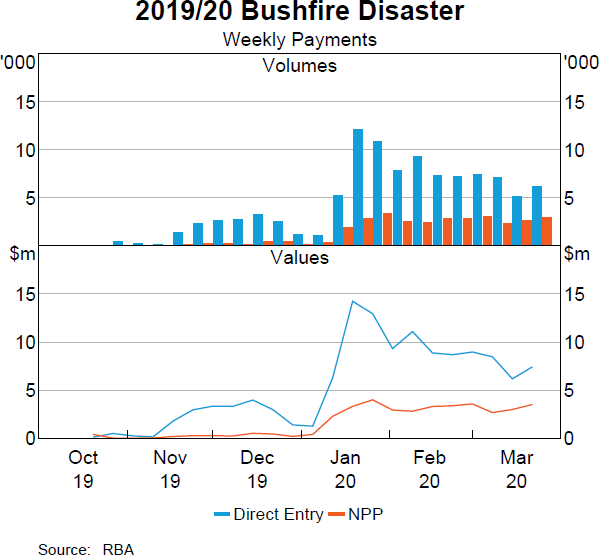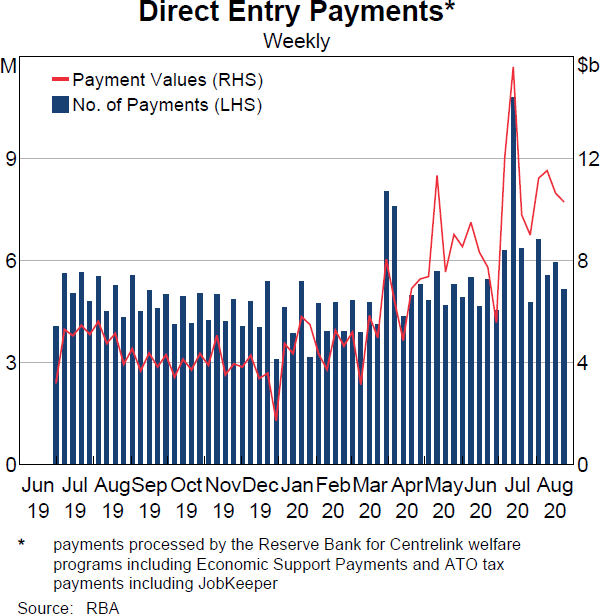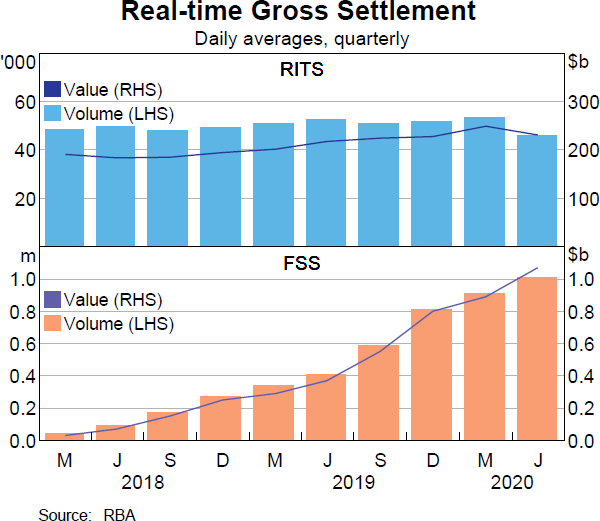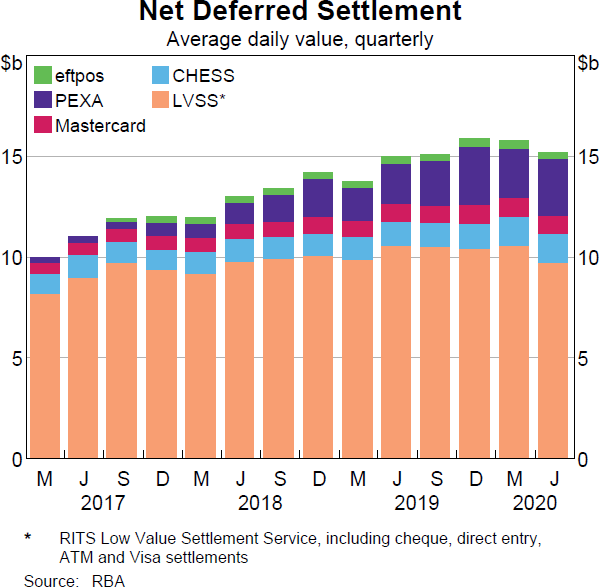Reserve Bank of Australia Annual Report – 2020 Banking and Payment Services August 2020
The Reserve Bank provides banking and payment services to meet the needs of the Australian Government and to support the efficient and stable functioning of the Australian financial system. These services have underpinned the Government's measures to support Australian households and businesses during the COVID-19 pandemic by ensuring that financial assistance payments were processed quickly and reliably. A key ingredient in achieving this has been the Bank's systems. In August 2019, the Bank completed a number of multi-year projects to renovate and strengthen its banking and settlement capabilities. In addition to operating Australia's real-time gross settlement (RTGS) system, the Bank operates national infrastructure to support the settlement of real-time payments by households and businesses on a 24/7 basis. The Bank also developed services that enable the Australian Government to access 24/7 payment capabilities. These services are consistent with the Bank's strategic goal of providing innovative, high-quality banking and payment services to the Australian Government and its agencies and, in turn, the Australian public.
Transactional Banking Services
The Reserve Bank aims to deliver secure and efficient banking and payment arrangements to the Australian Government and its agencies.
The provision of transactional banking services is consistent with the Reserve Bank's responsibilities under the Reserve Bank Act 1959, which requires the Bank to provide these services to the Australian Government if required. The key objective of the Reserve Bank's transactional banking function is to deliver secure, reliable and cost-effective services that meet the banking and payment needs of Australian Government agencies. Currently, the Bank provides transactional banking services to over 90 Australian Government agencies. While the Bank provides a broad range of payment and collection services, the bulk of the Australian Government's payments are made via the local low-value direct entry systems both domestically and overseas. The majority of these payments are welfare and pension payments made on behalf of Services Australia. The Australian Government also makes payments using a number of other methods, including NPP, RTGS, cheque, BPAY and prepaid cards. In 2019/20, the Bank processed around 326 million domestic and 1.1 million international payments, totalling $658 billion and $13 billion respectively. In line with broader industry trends, cheque payment volumes continued to decline, falling by a further 14 per cent over the course of 2019/20.
In addition, the Reserve Bank provides Australian Government agency customers such as the Australian Taxation Office (ATO) with access to a number of services through which they can collect monies owed from both domestic and international payers. These include direct entry, RTGS, BPAY, cheque, eftpos, cash, NPP and card-based services via the internet and phone. The Bank processed 39 million collections-related transactions for the Australian Government in 2019/20, amounting to $570 billion. Agencies continue to actively encourage customers to use more efficient electronic payment options with electronic payments now representing 99 per cent of all collections-related transactions in 2019/20.
As an Australian Government agency, the Reserve Bank's transactional banking services are subject to the Australian Government's competitive neutrality guidelines. To deliver such services, the Bank operates in a competitive environment, bidding for business via tenders conducted by the agencies themselves. The Bank must also cost and price the services separately from its other activities, including central banking services, and meet a prescribed minimum rate of return.
The nature of the transactional banking services offered by the Reserve Bank is evolving rapidly with changes in payments technology and business processes. As this is occurring, the Bank works closely with the industry to deliver new solutions. Bank staff also contribute to industry initiatives to ensure the interests of the Government, as a significant user of payment services, are represented. The Bank supports its government agency customers to embrace new technologies and processes to deliver convenient, reliable and cost effective payment options that meet the needs of their customers. For some services, the Bank combines its specialist knowledge of the government sector with specific services and products from commercial providers. In 2019/20, the Bank worked with Services Australia to expand the use of Application Programming Interface (API) services and NPP overlay capabilities for government payments. These capabilities enable full integration with government systems, facilitating real-time enquiry and payments processing. These new technologies and 24/7 capabilities introduced by the Bank ensure that the Government can meet the growing expectations of the community around reliability and speed of payments.
During extraordinary times the Australian Government uses the banking and payment services of the Reserve Bank to ensure timely support can be provided to affected households and businesses. This was demonstrated during the Australian bushfires during the summer of 2019/20, when the Bank processed and delivered more than 136,000 bushfire relief payments to affected people throughout the country with a total value of around $163 million. The number of bushfire relief payments processed was more than the total number of disaster recovery payments made in the 2018/19 financial year, including the Far North Queensland floods and Northern New South Wales bushfires.


As part of its economic response to the COVID-19 pandemic, the Australian Government provided a number of stimulus measures to support households and businesses, including Economic Support Payments (ESP) and JobKeeper payments. The Reserve Bank supported the Government by ensuring payments were made quickly and efficiently. In addition, the Bank developed bespoke payment processing functionality for the ATO to streamline the JobKeeper payment process, ensuring there was no delay in delivering payments to eligible recipients.
The Reserve Bank has undertaken a significant program of work to upgrade its banking systems since 2012. The objective was to upgrade the account maintenance system and systems used to process government payments and collections to a more modern programming language and architecture. The seven-year upgrade project took place through several major releases and was completed in August 2019.

Pro forma business accounts for transactional banking are provided below. After-tax earnings from the Reserve Bank's transactional banking services were $4.7 million in 2019/20, $1.6 million lower than in the previous year.
Pro forma Business Accounts
The following sets of accounts for the Reserve Bank's contestable businesses have been prepared in accordance with competitive neutrality guidelines. These accounts do not form part of the audited financial statements.
| 2019/20 $ million | 2018/19 $ million | |
|---|---|---|
| Revenue | ||
| – Service fees | 114.4 | 122.8 |
| – Other revenue | 2.9 | 2.7 |
| Total | 117.3 | 125.5 |
| Expenditure | ||
| – Direct costs | 110.7 | 116.9 |
| – Indirect costs | 0.0 | 0.0 |
| Total | 110.7 | 116.9 |
| Net profit/(loss) | 6.6 | 8.6 |
| Net profit/(loss) after taxes(a) | 4.7 | 6.3 |
| Assets(b) | ||
| – Domestic markets investments | 2,674.0 | 3,024.2 |
| – Other assets | 26.9 | 39.2 |
| Total | 2,700.9 | 3,063.4 |
| Liabilities(b) | ||
| – Capital & reserves | 25.0 | 25.0 |
| – Deposits | 2,663.5 | 3,023.2 |
| – Other liabilities | 12.4 | 15.2 |
| Total | 2,700.9 | 3,063.4 |
Source: RBA |
||
Central Banking Services
As part of the central banking services that the Reserve Bank provides to the Australian Government, the Bank manages the consolidation of Australian Government agency account balances. The consolidation of balances requires the movement of agency account balances held with commercial financial institutions and with the Reserve Bank into the Official Public Account. Daily payment instructions from the Department of Finance (Finance) are processed to move funds from the Government's accounts with the Reserve Bank to agency bank accounts to meet their payment obligations. Over the course of the year, the Bank has been working with Finance on its multi-stage plan to modernise the Australian Government's cash management activities. Phase 1 of the project was completed in March 2020 and involved the implementation of New Payments Platform (NPP) capability to facilitate whole-of-government funding payments. As a result, Australian Government agencies are now able to access their funds in near real-time on a 24/7 basis if required.
While the Reserve Bank manages the consolidation of the Government's accounts, the Australian Office of Financial Management (AOFM) has responsibility for ensuring there are sufficient cash balances to meet the Government's day-to-day spending commitments and for investing excess funds in approved investments, including term deposits with the Reserve Bank. The Bank also provides a very limited short-term overdraft facility to cater for occasions when there is unexpected demand for government cash balances. This overdraft facility is used infrequently and was drawn upon once in the reporting period.
The Reserve Bank also provides banking to overseas central banks and Registry services to supranational organisations issuing Australian dollar-denominated securities. Eight organisations currently use Registry services, with this number having been relatively steady over recent years.
Settlement Services
The Reserve Bank Information and Transfer System (RITS) infrastructure, which is owned and operated by the Reserve Bank, is critical to the fast and reliable transfer and settlement of payment obligations between financial institutions. Settlements, which result mostly from their customers' transactions, take place through crediting and debiting of Exchange Settlement Accounts (ESAs) held by these institutions at the Bank. Payments that are settled on a real-time gross settlement (RTGS) basis include high-value customer, corporate and institutional payments, wholesale debt and money market transactions and the Australian dollar leg of foreign exchange transactions. In 2019/20, RITS settled an average of 50,600 payments each day, worth $233 billion. RITS also provides a real-time settlement service, known as the Fast Settlement Service (FSS), to support the operation of the New Payments Platform (NPP). The NPP and FSS enable retail and corporate customers to make and receive payments immediately, 24 hours a day by using simple identifiers (PayIDs) such as email addresses, phone numbers or Australian Business Numbers (ABNs). RITS also provides deferred net settlement services for low-value retail payment systems, equity settlements and settlement of property-related transactions.
The onset of the COVID-19 pandemic had a significant impact on settlement activity. Up until early March 2020, the volume and value of daily settlements had been rising modestly, consistent with the pattern of settlement activity in previous financial years. However, volatile conditions in financial markets resulted in wholesale settlement activity in RITS rising sharply to reach a new daily settlement peak value on 18 March 2020 of $375 billion. Since then, as payments activity reduced in response to COVID-19 lockdown measures across the country, settlement activity declined to an average of around 47,500 settlements per day in June 2020, worth $231 billion. This decline was evident for all wholesale transaction types including SWIFT payments, Austraclear settlements and cash transfers in RITS.

Transactions settled via the FSS were less obviously affected by COVID-19. Growth in FSS settlement activity picked up sharply in the second half of 2019 as several banks completed their main NPP roll-out activities, and continued to grow throughout the first half of 2020, although at a slower rate. At the end of June 2020, there were over 4.9 million registered NPP PayIDs and 91 institutions offering NPP payments to their customers. In June 2020, the daily average number of interbank payments reached 1.1 million payments, worth around $1.2 billion. In addition to these interbank payments, the FSS also settles some intrabank transactions for which the payer and receiver of the settlement funds are the same institution. From March 2020, this has included some large-value government payments made by the Reserve Bank, which has contributed to strong growth in total values settled in FSS.
Despite continuing growth in the use of the NPP, most retail payments are still settled on a deferred net basis in RITS. In 2019/20, a daily average of around $10.3 billion of these payments were settled in the RITS Low Value Settlement Service (LVSS), which settles obligations arising from the clearing of cheques, some debit and credit cards, BPAY, ATMs and direct entry. Most direct entry transactions are settled in five intraday settlement runs, while other obligations are settled at 9.00 am the next business day. Although growth in LVSS has been strong in previous years, LVSS settlement activity was broadly steady through 2019 and the March quarter 2020, largely due to the migration of some direct entry payments to the NPP. In the June quarter 2020, LVSS settlement value declined by 8 per cent, driven by reduced payment activity associated with the outbreak of COVID-19.
The remaining net deferred settlements, with a daily average value of around $5.1 billion in 2019/20, are externally administered batch arrangements that use the RITS batch feeder facility. These include batches that settle obligations from Mastercard and eftpos transactions, stock market transactions processed by the ASX Clearing House Electronic Sub-register System (CHESS), and electronic property transactions processed by Property Exchange Australia Limited (PEXA) and Sympli Australia Pty Ltd. The card system and equity settlement batches are settled once per day at designated times, while the property batches enable settlement throughout the business day. Similar to LVSS transactions, the average daily value of the eftpos batch declined sharply in the June quarter 2020. The daily average value settled in the Mastercard and CHESS batches also fell slightly in the June quarter. In contrast, the daily average value settled through PEXA grew by around 15 per cent in the June quarter, consistent with strong growth in the use of electronic conveyancing over recent years. The ASX Financial Settlements (ASXFS) batch, as processed by Sympli Australia Pty Ltd, was introduced in late 2019, with limited settlement activity to date.

In 2019/20, seven institutions were approved as new RITS members. Five of these new members do not hold an ESA but are RITS members for the purpose of dealing with the Reserve Bank in its open market operations. As at 30 June 2020, RITS has 62 members that were active ESA holders, operating their own ESA to settle at least some of their payment obligations. A further 40 institutions were dormant ESA holders, using another ESA holder as a settlement agent to settle their payment obligations. An increased number of institutions expressed interest in, or applied to operate, an ESA during the year that were not authorised deposit-taking institutions (ADIs) compared with the previous year. In the year to 30 June 2020, 12 non-ADIs enquired about the eligibility requirements for operating an ESA, with two of these progressing to applications. These institutions were mostly non-traditional payment service providers, offering a range of services such as foreign currency remittance, prepaid multi-currency accounts or online card acquiring.
The Reserve Bank also offers correspondent banking services to other central banks and official sector institutions overseas to allow for settlement of certain Australian dollar payments, and provides safe custody services to these overseas agencies. The face value of securities held in custody by the Bank in this capacity was around $72 billion at the end of June 2020. The Bank also provides settlement services for banknote lodgements and withdrawals by commercial banks.
There were a number of other strategic developments and initiatives affecting RITS throughout 2019/20. Given the status of RITS as a systemically important payment system, the Reserve Bank carries out an annual assessment of the system against the internationally agreed Principles for Financial Market Infrastructures (PFMIs) developed by the Committee on Payments and Market Infrastructures (CPMI) and the International Organization of Securities Commissions. The June 2020 assessment rated RITS as ‘observed’ on all relevant PFMIs except for operational risk, which was rated as ‘broadly observed’, given ongoing initiatives as part of the Bank's Technology Stability Improvement Program. This program is aimed at improving the operational stability of RITS practices, including additional resources and training for IT roles supporting RITS and improvements to software patching processes.
In February 2020, the Reserve Bank and the Australian Payments Council (APC) completed a consultation with industry in relation to key strategic decisions required for the Australian high-value payments system to migrate to a new modern and consistent messaging standard (the ISO 20022 message standard). The migration project will involve moving messages currently used in some important parts of the payments system onto the ISO 20022 message standard, with the aim to improve message processing and enable expanded message content to support innovation in payments systems. This includes updates to the messages used to communicate with RITS for settlement of the High Value Clearing System. Australian Payments Network (AusPayNet) is coordinating this industry project and has held the first two meetings of the ISO 20022 Industry Migration Steering Committee. Since the release of the Reserve Bank and APC Conclusions paper, there has been a deferral to the start of migration for the international cross-border migration program. Accordingly, the ISO 20022 Industry Migration Steering Committee deferred the start of the domestic migration to November 2022, with migration at this stage still planned for completion by November 2024. The Bank will work cooperatively with industry in undertaking the migration.
Work is continuing on the Reserve Bank's refresh of the core network and application infrastructure of RITS and related systems, including the Bank's SWIFT infrastructure, with benefits expected to include enhanced security and resilience, and higher processing speeds.
The Reserve Bank also focuses on its continual uplift program for security and resiliency. It continues to enhance the security of external connections to RITS, in line with a strategy developed by the CPMI, and has engaged an external vendor to conduct a risk assessment of the connections between RITS and external parties, and recommend enhancements to current security requirements.[1] In December 2019, the Bank held its first industry cyber table-top exercise to rehearse industry communications, procedures and processes in the event of a cyber attack, and will be working with RITS members on the lessons from this exercise in the next financial year.
With the onset of the COVID-19 pandemic, the Reserve Bank took a number of actions to reduce potential operational risk associated with the altered operational environment for both itself and RITS members. As the majority of the Bank's staff transitioned to working-from-home arrangements, a small number of personnel occupying critical roles remained onsite at each of the Bank's two operating centres to support RITS operations and the Bank's back office settlement operations. Additional personnel were also trained and certified to fill critical roles in the event a large number of Bank staff were infected with or exposed to the virus. The Bank sent RITS Advices to members advising them of the Bank's arrangements and reminding RITS members of their ongoing obligations to satisfy minimum staff requirements to effectively manage their ESA and settlement activities, which are vital to the smooth operation of the payments system. In addition, the Reserve Bank engaged with major RITS feeder systems including SWIFT, Austraclear, ASX and PEXA to discuss contingency arrangements to manage the impact of COVID-19. Despite the potential risks associated with alternate working arrangements and heightened settlement activity in March, both RITS and FSS continued to operate smoothly, with RITS and FSS availability both at 100 per cent in 2019/20.
Footnote
For the CPMI strategy and its operationalisation toolkit see <https://www.bis.org/cpmi/publ/d178.htm> and <https://www.bis.org/cpmi/publ/d188.htm> respectively. [1]